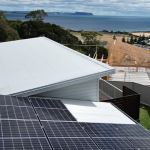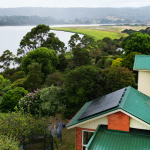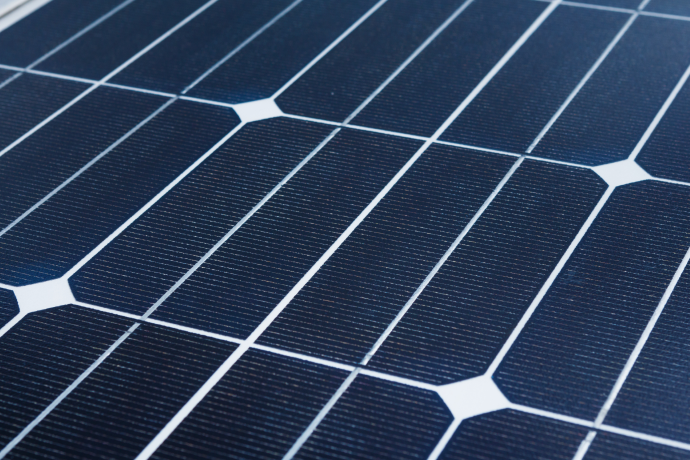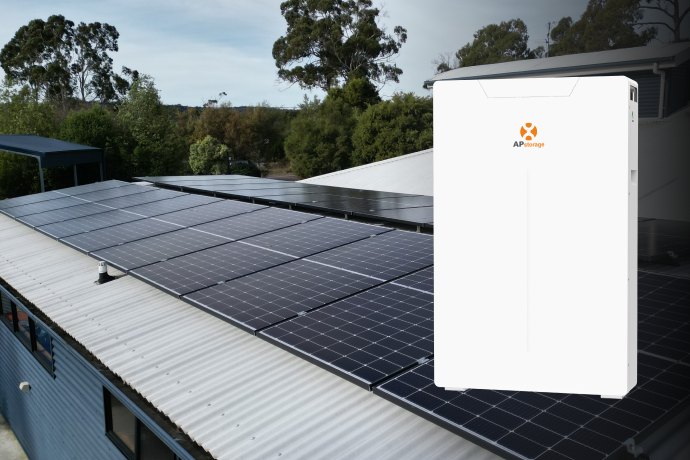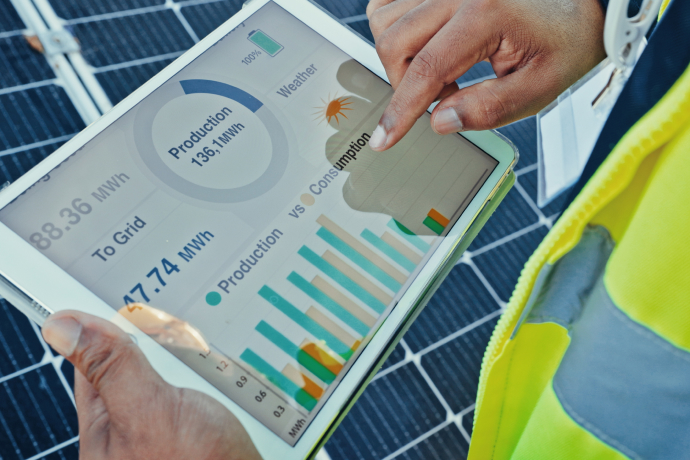Rooftop solar systems have dominated solar installations throughout Tasmania. However, if your roof is deemed unsuitable, then you may need to consider installing ground-mounted solar panels. Although they are more expensive and require more space, ground-mounted panels can potentially unlock even more solar energy. Prior to installation, it is important to consider if your space is suitable, while also determining your choice of mounting technology. While they are typically more complex to install, ground-mounted panels can be an excellent solution for maximising solar energy.

What Are Ground-Mounted Solar Panels?
A ground-mounted solar panel is just what it sounds like – a solar panel that is installed on the ground, instead of your roof. These panels are typically installed on frames anchored into the ground, with the metal framing designed to angle your panels for optimal sun exposure. These ground mounts can also be installed with a tracking system that moves the position of your panels to always face the sun. With this modern technology, ground-mounted solar panels have emerged as a great, high-efficiency alternative to traditional roof-mounted solar panels.
Ground Mounted Solar Panels vs Roof
If you’re considering installing ground-mounted solar panels, it’s important to understand their strengths and weaknesses compared to your typical rooftop installations.
Pros of ground-mounted solar panels
- Bypass roof issues – Not everyone has a roof suitable for solar panels. You could have limited roof space to support your optimal system size. Your roof could be too old or structurally weak, making extensive solar installations unsuitable. Choosing a ground-mounted system can bypass these potential problems.
- Maximise sunlight exposure – If you place solar panels on your roof, you are typically restricted to the available roof space you have. Often, this doesn’t allow you to maximise your energy production from the sun, in which your panels are set to your roof’s general direction and position. Conversely, ground-mounted solar panels can be freely positioned to an optimal angle and direction for sunlight exposure, and can be more easily altered to track the sun at different points.
- Easy access – Because they are not up on your roof, ground-mounted solar panels are easy to access. This makes cleaning, or general maintenance, much simpler, allowing you to provide general service without the safety risks on your roof.
- Simple expansion – Because ground-mounted solar panels aren’t limited by the constraints of your roof, future expansion to your system is generally much easier.
Cons of ground-mounted solar panels
- Higher cost – Because ground-mounted panels need a completely new foundation, unlike roof installations, which are generally attached directly to roofing, they are usually 10 to 15% more expensive. Added wiring and trenching for connection will also increase the cost compared to roofing systems.
- Takes up valuable space – Without solar panels, your roof is just empty real estate. Conversely, Ground-mounted solar panels can take up considerable space, which can be an issue, particularly in residential settings.
- Visual aesthetic – You may find that ground-mounted panels look bulky and aesthetically ugly when installed in your backyard. They may change the overall appearance of your precious backyard space, unlike sleek, rooftop installations.
- More prone to damage – Your panel’s position on flat ground opens it up to more avenues for damage. This could include wild animals, objects falling or hitting them, flooding or vandalism.
- Approval requirements – You may also face more stringent regulations than rooftop solar. Local zoning, council approval or environmental regulations can add further steps to your installation.
Are Ground-Mounted Solar Panels Right For My Home?
Although ground-mounted solar panels provide great benefits, their installation is not possible for everyone. Depending on your available space, installing solar panels on the ground may be more difficult. In a perfect world, you will want the following area:
- Open space – This will depend on the size of your solar panel installation, but generally we recommend you have a 350 square metre space. This will be enough to accommodate your standard household capacity of 5 kilowatts (kW)
- No shading – Your area should not be heavily shaded by trees or anything blocking out sunlight.
- Close to the electrical grid – Ideally, just a few metres away to avoid additional expenses on extensive wiring and trenching.
- Satisfactory ground conditions – Your panel installation may require concrete foundations if your soil is too soft, or if it’s too hard, you may have to undertake pre-drilling. Your ground must be stable and sturdy for a solid foundation.
- Flat or gently sloping land – Land should be flat or gently sloping to the south. Anything more than a 5-degree slope will typically require racking systems to accommodate the angle.
- Avoid flood zones – Not on a 100-year flood plain, which is an area that has a 1% chance of being flooded each year.
Types of Ground-Mounted Solar Systems
As part of your solar installation, you will be required to choose your type of racking system. Racking refers to the framework of your solar system that keeps your panels in position. See below for the main types of solar racking systems:
- Traditional – The most cost-effective method. A traditional system incorporates a simple, metal framing, which is driven into the ground and then connected to the panels to form a frame. This system can be moved manually to follow the sun, and is great for areas with predictable sunlight.
- Pole-Mounted System – Can be a great choice if you don’t have enough space for a full-sized ground-mounted solar system. Pole-mounted systems are mounted directly onto poles, which are driven into the ground. This system can also be installed onto any type of ground, and can often be included with a tracking device to follow the direct sunlight.
- Concrete ballasting – Instead of drilling into the ground, a racking system can be installed on a concrete footing. Steel frames are then connected to the concrete footing to form the framework for your solar panels. Great way to ensure maximum stability and resistance against adverse weather or extreme wind conditions.
- Ground Screw – This type of foundation uses steel screws which are driven into the ground, as an alternative to concrete footing.
- Single Axis Tracking – These tracking systems use motors and a control system to smartly follow the sun’s path throughout the day. The tracking system has a single-axis pivot, which alters the panel’s angle to keep it tilted at the optimal angle.
- Dual Axis Tracking Systems – Unlike single-axis tracking systems, a dual-axis tracking system can follow the sun both horizontally and vertically. With multiple motors allowing the panels to move in a more circular fashion. This is a great solution for maximising your energy output with the available sunlight.
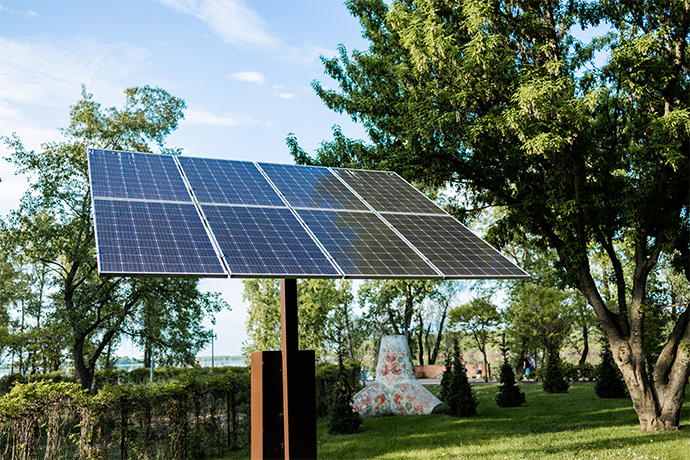
How Much Do Ground-Mounted Solar Panels Cost?
As with any solar panel installation, your costs will largely depend on a variety of factors. In particular, your chosen system size. Below is a table displaying the estimated costs for a fully installed ground-mounted system.
| Capacity (kW) | Price ($) – Before Rebate |
| 5 kW | $7,500 to $12,500 |
| 10 kW | $15,000 – $25,000 |
| 30 kW | $45,000 – $75,000 |
*Note: final costs will vary, and additional costs may apply for electrical upgrades or complex installations. Opting for more advanced racking systems will also incur added cost.
Installation Process
If you have all the necessary space to accommodate ground-mounted panels, then you can now move into the installation phase. The following steps are what you can expect during this installation process:
- Site is marked out – Your installer will evaluate your site. Taking note of sunlight exposure, potential shading, the slope of your land and your location relative to the electrical grid.
- Digging holes – Once you’ve received the all-clear for your site, the next step is digging holes in the ground for posts to support panels. This will change depending on your racking system, with concrete ballasting for instance not requiring extensive digging.
- Concrete foundation – Your posts are then set in concrete to ensure they are sturdy.
- System is built – Once your foundation is secure, your panel system is built. Involves carefully attaching your panels to your concrete posts. Your racking system will also be assembled during this time, which provides support for your solar panels
- Electrical wiring – Your panels are connected to your home’s main electrical panel via wiring. Extensive trenching may be required if panels are further away.
- Inverter – The Inverter is installed, which allows you to convert DC electricity generated to AC for your home. The inverter is connected to your solar panels and placed in a safe position, preferably away from direct sunlight, which can reduce their lifespan.
- System testing – Once everything is connected and installed, your system is tested to ensure proper functionality.
Installation FAQ’s
How long should the installation process take?
- The length of your installation will depend on the size and complexity of your system. Generally, your installation will take anywhere from a few days for smaller sizes to several weeks for bigger systems. This includes permitting, site preparation and the panel installation itself.
What council approval is required?
- Ground-mounted installations must follow local zoning laws and building codes. Typically in Tasmania, you will need council approval if your system covers more than 38 square metres, or will be built on poles over 3m high. If you are unsure about which council approval you need, please contact your local installer.
Do you need a fence around ground-mounted solar panels?
- Although a fence is not required for your ground-mounted panels, it could be a great addition for the following reasons. Firstly, for security reasons, installing a fence can prevent theft or vandalism. It can increase safety by reducing the potential for accidents to occur. It also acts as a great protection system from animals, which could damage your panels.
Ground-mounted solar panels are a great solution for anyone with an unsuitable roof and ample yard space. Although they cost more, these panels have the potential to produce more energy than a rooftop system. Prior to installing these panels, you should be across both your racking options and the suitability of your home. Choosing a trusted installer such as the team at TSS can ensure you are across every step of the installation process. With our Solar Accreditation Australia (SAA) team, you can rest assured, knowing you are in good hands.

